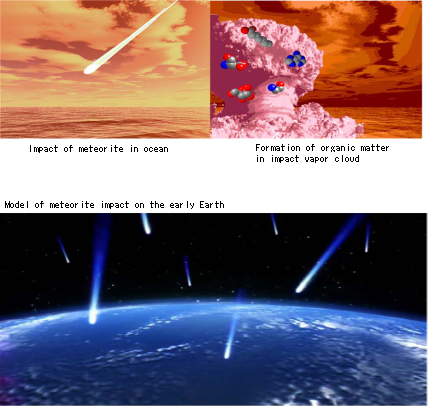A team led by Dr. Hiromoto Nakazawa, an Honorary Fellow of the National Institute for Materials Science, in joint work with the Tohoku University Graduate School of Science, confirmed the formation of glycine, (amino acid), various species of amine, various carboxylic acids (fatty acids) and other bioorganic molecules and their precursors in an experiment in which carbon (solid), iron, nickel, water, and nitrogen gas were packed in a stainless steel capsule. The capsule was impacted with a high speed flying object and then recovered, and the formation products were analyzed. This experiment simulated the chemical reactions when meteorites bombarded the oceans of the early Earth. Meteorites were frequent around 4.0-3.8 billion years ago, when oceans had appeared on the Earth. Thus, this experiment strongly suggests the origin of the bioorganic molecules that became the starting point for the origin of life.
In 1953, S.L. Miller demonstrated that several amino acids and bioorganic molecules form as a result of electrical discharge in a gas containing CH4 (methane), NH3 (ammonia), and H2O (water). This composition was based on the model of the Earth’s primeval atmosphere at the time. The experiment became the starting point for scientific research on the origin of life. Miller’s work was followed by other experiments using diverse energy sources in place of electrical discharge, including electron beams, ultraviolet rays, X-rays, and shock waves. Because it was found that basically the same results can be obtained with a reducing atmosphere composition that includes either methane or ammonia, scientists considered that organic molecules were easily formed on the primitive Earth. However, at the same time, research had also demonstrated that organic molecules do not form in a non-reducing or oxidizing atmospheres in which the main component is N2 (nitrogen) or CO2 (carbonic acid gas).
S.L. Miller’s simple experiment and model of lightning, which seems possible in nature, were generally widely believed to be the origin of organic molecules, and were introduced in middle school and high school science texts and supplementary reading materials. However, earth science, which progressed rapidly from the 1970s through the beginning of the 21st century, revealed that the primitive Earth was not cool, but the entire Earth was once hot enough to melt, and a sea of magma (called the “magma ocean”) appeared on the primitive Earth. Therefore, even assuming hypothetically that organic molecules and reducing molecules such as methane and ammonia existed in the atmosphere, these would have been decomposed by contact with the high temperature magma (>1200°C), and light hydrogen would have escaped into space. As a result, it is now assumed that the primitive atmosphere was an oxidizing atmosphere consisting mainly of nitrogen and carbon oxides. This destroyed the basic premise of hypotheses regarding the formation of organic molecules, like that in Miller’s experiment, which had been widely believed up to the time, and the origin of organic molecules was once again a mystery.
An elucidation of how the diverse kinds and large quantities of organic molecules necessary for life came to exist on Earth, which is rational in terms of the Earth’s history, is the first problem in explaining the origin of life. In 2006, on the basis of a consideration based on the view of the Earth at the end of the 20th century and preparatory experimental results, Dr. Nakazawa of this research group proposed a “big bang theory of organic molecules” which stated that “organic molecules formed in diverse kinds and large quantities as a result of the intense bombardment of the oceans of the early Earth by planetoids and meteorites.” (1) This is a new Japanese-originated scenario of the origin of organic molecules. As grounds for this proposal, in the previous year, 2005, Dr. Nakazawa and his colleagues demonstrated that ammonia, which is a precursor of the amino acids, forms in large quantity when a shock wave is applied to nitrogen, water, and iron, these being the representative components of the primeval atmosphere, oceans, and meteorites.(2)
(1)
“The Origin of Life – A Scenario Written by the Earth,” Nakazawa H., Shinnihon Shuppansha (2006).
(2)
“High yield shock synthesis of ammonia from iron, water and nitrogen available on the early Earth,” Nakazawa, H., Sekine, T., Kakegawa, T., and Nakazawa, S., Earth Planet. Sci. Let. 235, 356-360 (2005).

Hypothesis of the formation of organic matter demonstrated by this research